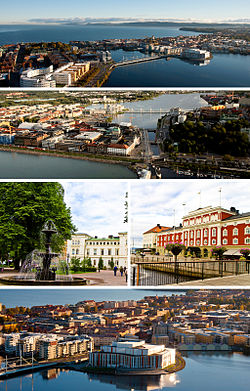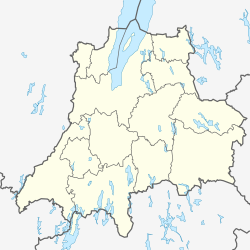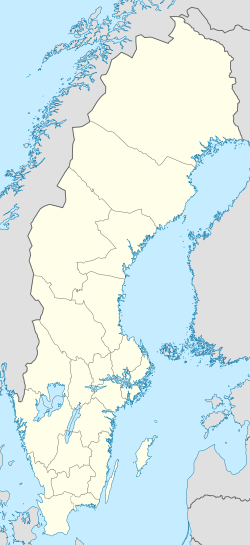This article needs additional citations for verification. (July 2010) |
Jönköping (/ˈjɜːn(t)ʃɜːpɪŋ/,[3][4] Swedish: [ˈjœ̂nːˌɕøːpɪŋ] ⓘ) is a city in southern Sweden with 112,766 inhabitants (2022).[5] Jönköping is situated on the southern shore of Sweden's second largest lake, Vättern, in the province of Småland.
Jönköping | |
|---|---|
 Collage of Jönköping | |
| Coordinates: 57°46′58″N 14°09′38″E / 57.78278°N 14.16056°E | |
| Country | |
| Province | Småland |
| County | Jönköping County |
| Municipality | Jönköping Municipality |
| City status | 1284 |
| Area | |
• City | 44.82 km2 (17.31 sq mi) |
| Elevation | 104 m (341 ft) |
| Population (31 May 2022)[1] | |
• City | 112,766 |
| • Density | 2,500/km2 (6,500/sq mi) |
| • Metro | 144,699[2] |
| Time zone | UTC+1 (CET) |
| • Summer (DST) | UTC+2 (CEST) |
| Postal code | 555 xx |
| Area code | (+46) 36 |
| Vehicle registration | 1544 |
| Climate | Dfb |
| Website | www |
The city is the seat of Jönköping Municipality, which has a population of 144,699 (2022) and is Småland's most populous municipality.[6] Jönköping is also the seat of Jönköping County which has a population of 367,064 (2022).[7] Jönköping is the seat of a district court and a court of appeal as well as the Swedish National Courts Administration.[8] It is also the seat of the Swedish Board of Agriculture.[9]
County government
editThis section may require cleanup to meet Wikipedia's quality standards. The specific problem is: too much detail. (July 2023) |
The Jönköping municipality has its headquarters in a place called rådhuset. Rådhuset is an important component of the function of the municipality as it works as a state office for different departments of and in Jönköping. Rådhuset is dependent on the municipality but is its own entity, the head of the rådhuset has political power but is not the head of the Jönköping state. The head of the Jönköping state is called the kommunfullmäktige which has all the municipal power but sometimes doesn't make the decisions; these are handed down to other departments or the kommunstyrelsen.[10]
The departments that are inherent to the office are not limited to but are shortly known as:
- The political governance
- This department has a municipal board that is responsible for the state office's official activities.
- The administrative department
- The administrative department is responsible for office operations, city archives, legal functions, the office of the guardianship board, data protection (GDPR), and information security.
- The analysis and sustainability department
- The analysis and sustainability department is responsible for sustainability issues, international collaboration, consumer advice, energy, and climate advice, as well as statistics and investigations.
- The state economics department
- The state economics department is the solely responsible force regarding the official spending of the municipality's funds.
- The finance and company departments
- The finance and company department is responsible for the municipality's and the municipal companies' financial management and administers "Jönköpings Rådhus AB" and manages the municipality's donation funds.
- The HR department
- This department is responsible for personnel issues, work environment, negotiations, as well as managerial and personnel development and acts as a development and service body for the municipal administrations.
- The IT department
- Responsible for and coordinates the municipality's IT operations and telephony. The department works closely with the municipal administrations and provides the operation and development of systems, services, and products. This is also offered to municipal companies. In case of problems, questions, or need for help, the IT department supports the administrations and the municipal companies.
- The communication department
- Responsible for the municipality's overall internal and external communication. The municipality's overall communication channels, graphic profile, and press issues are also within the department's area of responsibility. The Communications Department works in close cooperation with the municipal administrations and supports them in their communication work. The department also includes the municipality's Contact Center. The contact center is the public's first contact with the municipality for general questions and information.
- The business department
- The department works to create conditions for the development and expansion of the existing business community and to stimulate and facilitate new establishments.
- The Procurement Department
- Responsible for the municipality's procurement activities and coordination of procurements. The department also conducts procurements in collaboration with Habo and Mullsjö municipalities as well as Rådhus AB and its subsidiaries.
History
editJönköping is an old trading centre (Köping) situated at a natural crossroads for routes following the rivers Nissan and Lagan, and the road connecting the provinces of Östergötland and Västergötland, a result of the town's geographical position at the southern end of lake Vättern, which divides the two provinces.
On 18 May 1284 Jönköping became the first City in Sweden to be granted its rights by king Magnus Ladulås, who ruled mostly from Vättern's largest island Visingsö.[clarification needed] The first part of the city's name, "Jön", is derived from a creek, "Junebäcken", in Talavid, in what is now the western part of the city. The second part of the name "köping", is, as mentioned above, an old word for a trading centre or market place.[11]
The geographical position of the city also left it vulnerable to attack via the river routes that led south, mainly from Danes. At that time the provinces of what is today southern Sweden – Scania, Halland and Blekinge – belonged to Denmark. The city was plundered and burned several times until it was fortified during the 16th and 17th centuries.
Jönköping was known for its matchstick industry between 1845 and 1970.[12] The phosphorus match was invented in 1831, and these matches became very popular because one could strike it against any surface to ignite it. However, the problem was that they ignited too easily, caused a lot of accidents and were toxic. In 1844, Swedish professor Gustav Erik Pasch patented a new invention, "Safety matches – Strike against the box only".[13] To prevent the matches from igniting so easily, Gustav Erik Pasch separated the chemicals in the match head and placed the phosphorus on a separate surface on the outside of the box for striking ignition. Johan Edvard and Carl Frans Lundström took Pasch's patent and improved it. Later, they manufactured their new Safety matches in their factory in Jönköping.[14] Today, the Match Museum is located in Jönköping's first match factory.
Present
editThe urban area of Jönköping today includes the eastern industrial town of Huskvarna, with which it has grown together.[15]
Elmia, a major trade fair and exhibition centre, is situated in Jönköping. Elmia Wood is the world's largest forestry fair,[16][17] and fairs for subcontractors, trucks, caravans and railways are the biggest of their kind in Europe. Since 2001, Elmia has been the site of the world's largest LAN party, DreamHack, with two events every year, Dreamhack Summer and Dreamhack Winter.
The city is an important Nordic logistical center, with many companies' central warehouses (such as Elkjøp, IKEA, Electrolux and Husqvarna) situated there.[18][19][20]
In late 2019, Jönköping was seen as the city with best future prospects in Sweden by WSP.[21]
Demography
editPopulation
editAs of 2018, Jönköping has a total population of 139,222.[22]
| Gender | 2014 | 2015 | 2016 | 2017 | 2018 | 2019 |
|---|---|---|---|---|---|---|
| Female | 66,404 | 66,987 | 67,823 | 68,722 | 69,426 | 70,265 |
| Male | 65,736 | 66,323 | 67,474 | 68,759 | 69,796 | 70,816 |
| Total | 132,140 | 133,310 | 135,297 | 137,481 | 139,222 | 141,081 |
Population changes
edit| 2014 | 2015 | 2016 | 2017 | 2018 | 2019 | |
|---|---|---|---|---|---|---|
| Population increase | 1,342 | 1,170 | 1,987 | 2,184 | 1,741 | 1,859 |
| Born | 1,677 | 1,662 | 1,715 | 1,615 | 1,688 | 1,644 |
| Deceased | 1,169 | 1,217 | 1,101 | 1,202 | 1,253 | 1,100 |
Average age 2019
edit| Area | Female | Male | Female and Male |
|---|---|---|---|
| Jönköping | 41.3 | 39.2 | 40.3 |
Notable people
edit- Johan Björnsson Printz, (1592–1663) governor of the Swedish colony of New Sweden
- Carl Peter Thunberg, (1743–1828), botanist
- Aurore Storckenfeldt, (1816–1900), educator
- Swante M. Swenson, (1816–1896) founder of the SMS ranches in Texas
- Viktor Rydberg (1828–1895), author,[23]
- Carl Lotave, (1872–1924) artist, portrait painter
- John Bauer, (1882–1918) illustrator, painter
- Bernhard Karlgren, (1889–1978) sinologist and linguist
- Dag Hammarskjöld, (1905–1961) former United Nations Secretary-General
- Martin Allwood, (1916–1999) an educator, writer, sociologist, translator and professor.
- Per G. Malm, (1948–2016) leader in The Church of Jesus Christ of Latter-day Saints
- Carl Henrik Fredriksson, (born 1965) editor-in-chief and co-founder of Eurozine
- Vladimir Oravsky (born 1947) author and film director
- Kenneth Breslauer (born 1947) chemist and chemical biologist
- Jacob Karlzon (born 1970)
- Fredrik Neij, (born 1978) founder of The Pirate Bay BitTorrent-tracker
- David F. Sandberg, (born 1981) film director
- Mona Johannesson, (born 1987), model
Music
edit- Agnetha Fältskog, (born 1950) singer/songwriter and member of ABBA
- Nina Persson, (born 1974) vocalist with The Cardigans
- Amy Diamond, (born 1992), singer
- The Motorhomes, (created in 1997) rock band
- The Mary Onettes, (formed in 2000) indie rock band
- I'm from Barcelona, (formed in 2005) 29-piece indie pop band
- Aril Brikha, (born 1976) techno-musician
- Olle Widestrand, (born 1932-2018) pianist-composer
Sport
edit- Gunhild Larking, (born 1936) high jump
- Göran Kropp, (1966–2002) mountaineer
- Anders Gustafsson, (born 1979) kayaker, Olympian
- Sofia Paldanius, (born 1979) kayaker, Olympian
- Stefan Liv, (1980–2011) an ice hockey goaltender, Olympian
Art
editEducation
editHigh schools
edit- Bäckadalsgymnasiet
- Erik Dahlbergsgymnasiet
- Per Brahegymnasiet
- Sandagymnasiet
- Thoren Business School
- LBS: High School of Creativity
Tertiary education
editClimate
editJönköping's climate was humid continental (Köppen Dfb) with long, cold winters and short, warm summers during the 1961–1990 period. However, the window between subarctic and oceanic is very small in this marine-influenced climate type, and in recent years the climate has more resembled very cold oceanic. However, figures are slightly skewed due to the weather station being located at the airport which is at an elevation of 228 metres (748 ft), whereas the city centre is at 100 metres (330 ft). This likely renders up to between half a degree to a full degree milder temperatures in the urban centre.
| Climate data for Jönköping Airport 2002–2018; extremes since 1901 | |||||||||||||
|---|---|---|---|---|---|---|---|---|---|---|---|---|---|
| Month | Jan | Feb | Mar | Apr | May | Jun | Jul | Aug | Sep | Oct | Nov | Dec | Year |
| Record high °C (°F) | 11.5 (52.7) |
15.8 (60.4) |
21.1 (70.0) |
26.3 (79.3) |
30.9 (87.6) |
34.5 (94.1) |
36.7 (98.1) |
34.2 (93.6) |
29.5 (85.1) |
22.4 (72.3) |
17.0 (62.6) |
12.7 (54.9) |
36.7 (98.1) |
| Mean maximum °C (°F) | 8.7 (47.7) |
11.1 (52.0) |
16.3 (61.3) |
21.3 (70.3) |
26.8 (80.2) |
30.3 (86.5) |
31.5 (88.7) |
29.6 (85.3) |
24.2 (75.6) |
18.3 (64.9) |
14.0 (57.2) |
10.4 (50.7) |
32.5 (90.5) |
| Mean daily maximum °C (°F) | 1.2 (34.2) |
1.7 (35.1) |
5.6 (42.1) |
12.0 (53.6) |
17.3 (63.1) |
20.5 (68.9) |
22.9 (73.2) |
22.3 (72.1) |
17.3 (63.1) |
10.9 (51.6) |
6.0 (42.8) |
3.0 (37.4) |
11.7 (53.1) |
| Daily mean °C (°F) | −1.5 (29.3) |
−1.3 (29.7) |
2.2 (36.0) |
6.7 (44.1) |
12.0 (53.6) |
15.4 (59.7) |
18.1 (64.6) |
17.6 (63.7) |
12.9 (55.2) |
8.1 (46.6) |
3.7 (38.7) |
1.0 (33.8) |
7.9 (46.3) |
| Mean daily minimum °C (°F) | −4.2 (24.4) |
−4.2 (24.4) |
−1.9 (28.6) |
2.4 (36.3) |
6.5 (43.7) |
11.1 (52.0) |
13.2 (55.8) |
12.7 (54.9) |
8.6 (47.5) |
5.2 (41.4) |
1.9 (35.4) |
−1.2 (29.8) |
4.2 (39.5) |
| Mean minimum °C (°F) | −14.8 (5.4) |
−14.2 (6.4) |
−9.9 (14.2) |
−6.1 (21.0) |
−2.3 (27.9) |
3.8 (38.8) |
7.7 (45.9) |
5.2 (41.4) |
−0.2 (31.6) |
−4.7 (23.5) |
−8.4 (16.9) |
−11.6 (11.1) |
−15.6 (3.9) |
| Record low °C (°F) | −31.8 (−25.2) |
−34.2 (−29.6) |
−29.1 (−20.4) |
−16.9 (1.6) |
−5.8 (21.6) |
−0.2 (31.6) |
1.7 (35.1) |
0.6 (33.1) |
−5.3 (22.5) |
−11.6 (11.1) |
−19.5 (−3.1) |
−25.8 (−14.4) |
−34.2 (−29.6) |
| Average precipitation mm (inches) | 36.2 (1.43) |
29.5 (1.16) |
20.4 (0.80) |
27.7 (1.09) |
38.4 (1.51) |
56.9 (2.24) |
80.4 (3.17) |
85.6 (3.37) |
60.1 (2.37) |
58.0 (2.28) |
52.1 (2.05) |
49.5 (1.95) |
594.8 (23.42) |
| Source 1: SMHI Average Data 2002–2018[24] | |||||||||||||
| Source 2: SMHI Open Data[25] | |||||||||||||
Sport
edit- HV71, men's ice hockey team currently playing in the SHL.
- HV71 Dam, women's ice hockey team in the SDHL
- Jönköpings IK (JIK), floorball team who has played several season in the men's Swedish Super League.
- Jönköpings Södra IF, football (soccer) team in Superettan (second-tier league of Sweden).
- Husqvarna FF, football (soccer) team in Division 1 (third-tier league of Sweden).
- IK Tord, football (soccer) team in Division 2 Västra Götaland (fourth tier league of Sweden).
- Jönköping Bandy IF, bandy team in Allsvenskan (second-tier league of Sweden).
- Jönköpings SS, swimming society, with Swedish champions in both swimming and diving. [citation needed] There are also three other water disciplines in the club, lifeguarding and synchronized swimming.
- ATP Challenger Tour event, starting in 2016.[26]
- Jönköping hosted the 1984 World Rowing Junior Championships and the 2019 European Universities Rowing Championships.
- Jönköping hosted the 2011 League of Legends World Championship.
Churches
editSee also
edit- Jönköping Municipality
- Swedish National Board of Agriculture
- International Ice Hockey Federation World Championships (2002, held in Jönköping)
- Tranhult
References
edit- ^ a b "Population in the country, counties and municipalities by sex and age". Statistics Sweden. 27 May 2013. Archived from the original on 16 January 2013.
- ^ "Folkmängd i riket, län och kommuner 30 september 2016 och befolkningsförändringar 1 juli–30 september 2016. Totalt". Archived from the original on 20 December 2016.
- ^ "Jönköping"[dead link] (US) and "Jönköping". Lexico UK English Dictionary. Oxford University Press. Archived from the original on 26 August 2022.
- ^ "Jönköping". Merriam-Webster.com Dictionary. Merriam-Webster. Retrieved 8 March 2019.
- ^ "Statistikdatabasen – välj variabler och värden". Archived from the original on 26 December 2016.
- ^ "Befolkningsstatistik". Jönköpings Kommun. Retrieved 4 April 2020.
- ^ "Folkmängd efter region och år". Statistiska Centralbyrån. Retrieved 4 April 2020.
- ^ "Domstolsverket (Swedish National Courts Administration)". Domstolsverket (in Swedish). Retrieved 14 December 2023.
- ^ "Swedish Board of Agriculture – How to find our headquarters". Swedish Board of Agriculture. Archived from the original on 28 September 2011. Retrieved 21 June 2011.
- ^ "Stadskontoret" [The City Administration]. Archived from the original on 31 October 2022. Retrieved 31 October 2022.
- ^ Wahlberg, Mats, ed. (2003). Svenskt ortnamnslexikon (PDF) (in Swedish) (1st ed.). Uppsala: Swedish Institute for Dialectology, Onomastics and Folklore Research. p. 158. ISBN 91-7229-020-X. Retrieved 22 January 2017.
- ^ Ohlsen, Becky; Kaminski, Anna; Lundgren, K (1 June 2012). Lonely Planet Sweden (5th ed.). Lonely Planet. ISBN 978-1741797268.
- ^ Wisniak, Jaime (May 2005). "Matches-The manufacture of fire". CSIR. 12 (3): 369–380 – via NISCAIR.
- ^ "History of matches". Swedish Match. Retrieved 21 April 2019.
- ^ "Ortshistoria Huskvarna". ortshistoria.se (in Swedish). 14 January 2008. Retrieved 14 December 2023.
- ^ "Elmia Wood". JKPG.com. Retrieved 14 December 2023.
- ^ "Elmia Wood back on in person for 2022". Wood Business. 7 February 2022. Retrieved 14 December 2023.
- ^ "Jönköping växer som logistikläge". Intelligent Logistik (in Swedish). 15 September 2017. Retrieved 14 December 2023.
- ^ Radio, Sveriges (23 June 2009). "P4 Jönköping". Sveriges Radio (in Swedish). Retrieved 14 December 2023.
- ^ Artell, Text Johanna; Dela artikeln (14 December 2023). "Smålands bästa logistikcentrum". Fastighetstidningen (in Swedish). Retrieved 14 December 2023.
- ^ "Jönköping anses ha bäst framtidsutsikt i landet". SVT Nyheter (in Swedish). 10 October 2019. Retrieved 1 January 2024.
- ^ "Befolkningsstatistik". Jönköpings Kommun. Retrieved 5 April 2020.
- ^ Gosse, Edmund William (1911). . Encyclopædia Britannica. Vol. 23 (11th ed.). p. 949.
- ^ "Monthly & Yearly Statistics". SMHI. Retrieved 28 June 2019.
- ^ "SMHI öppna data för Huskvarna". SMHI. Retrieved 30 June 2019.
- ^ "Jonkoping Challenger 2016 Feature | ATP Tour | Tennis".
External links
edit- Jönköping travel guide from Wikivoyage
- Official website
- article Jönköping from Nordisk familjebok, (in Swedish)


